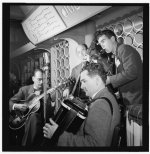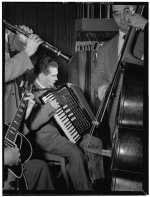I was curious how some well-known contemporary accordionists are recorded in professional studios, and what information could be gleaned from photos of them in action.
Here are five photos (below) of accordionists in the recording studio—Luciano Biondini, Pietro Roffi, Viviane Chassot, Toninho Ferragutti, and Richard Galliano.
This is not an exhaustive list of (my favorite) well-known players nor a rigorous study of recording techniques. Every sound engineer probably has their own preference for recording accordionists, depending on the musician(s), instrument, and situation. The ever-moving bass side of the accordion must add a bit of fun, too.
Some good folks on the Sound Engineering subreddit took a stab at identifying the mics in these five images. Condenser microphones (as opposed to dynamic mics) and specifically Neumann microphones (priced new between $3,000 and $5,000 USD) are, apparently, ubiquitous in these photos:

But even in this tiny sampling of recording sessions with contemporary accordionists, I was surprised by the variation of microphone positions and placements around the instrument, especially distance and height.
Accordionist and recording engineer David Lange has tackled the nuts and bolts of recording the accordion. In his video tutorial, Lange tests and recommends a series of mics using his Petosa, including an ATM 35 attached directly to the exterior of the bass section. Lange's recordings sound wonderful, in my opinion, and the YouTube tutorial is both in-depth and practical, likely aiming to assist non-pro accordionists recording at home with *non-professional* budgets. (None of the microphones Lange demonstrated in his tutorial make an appearance in the photos posted here, to my knowledge.)
This is all just casual exploration and fun after a few photos piqued my curiosity. I appreciate how forum members with recording expertise regularly share their knowledge on this website. @JerryPH comes to mind as well as many folks in this thread: https://www.accordionists.info/threads/your-accordion-recording-technique.8354/
To be clear: I will still be using my iphone to record for the foreseeable future!


Edited on 2022-06-12 for clarity and to add new information.

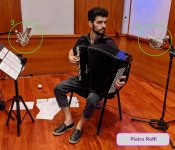

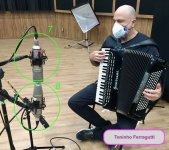
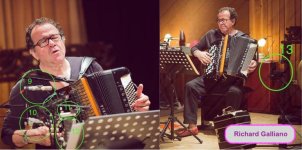
Here are five photos (below) of accordionists in the recording studio—Luciano Biondini, Pietro Roffi, Viviane Chassot, Toninho Ferragutti, and Richard Galliano.
This is not an exhaustive list of (my favorite) well-known players nor a rigorous study of recording techniques. Every sound engineer probably has their own preference for recording accordionists, depending on the musician(s), instrument, and situation. The ever-moving bass side of the accordion must add a bit of fun, too.
Some good folks on the Sound Engineering subreddit took a stab at identifying the mics in these five images. Condenser microphones (as opposed to dynamic mics) and specifically Neumann microphones (priced new between $3,000 and $5,000 USD) are, apparently, ubiquitous in these photos:
- Neumann M 149 - #1
- Neumann U 87 - #2, 3, 4, 7, 8
- Neumann KM 184 (or possibly Beyerdynamic MC series) - #5, 6
- Sony C-800 - #13
But even in this tiny sampling of recording sessions with contemporary accordionists, I was surprised by the variation of microphone positions and placements around the instrument, especially distance and height.
Accordionist and recording engineer David Lange has tackled the nuts and bolts of recording the accordion. In his video tutorial, Lange tests and recommends a series of mics using his Petosa, including an ATM 35 attached directly to the exterior of the bass section. Lange's recordings sound wonderful, in my opinion, and the YouTube tutorial is both in-depth and practical, likely aiming to assist non-pro accordionists recording at home with *non-professional* budgets. (None of the microphones Lange demonstrated in his tutorial make an appearance in the photos posted here, to my knowledge.)
This is all just casual exploration and fun after a few photos piqued my curiosity. I appreciate how forum members with recording expertise regularly share their knowledge on this website. @JerryPH comes to mind as well as many folks in this thread: https://www.accordionists.info/threads/your-accordion-recording-technique.8354/
To be clear: I will still be using my iphone to record for the foreseeable future!
Edited on 2022-06-12 for clarity and to add new information.





Last edited:

